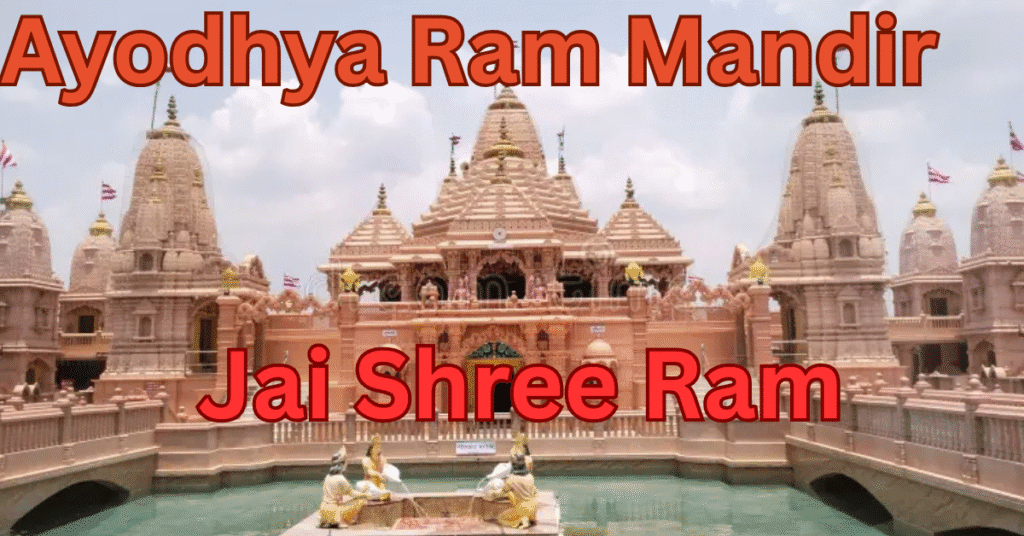
Table of Contents
Ayodhya Ram Mandir
Ayodhya Ram Mandir
The Ram Mandir in Ayodhya, Uttar Pradesh, is not just a religious edifice—it’s a spiritual, cultural, and emotional epicenter for millions of Hindus across the world. Built on the sacred Ram Janmabhoomi, believed to be the birthplace of Lord Rama, the temple today represents centuries of devotion, a landmark legal resolution, and a new age of national unity. As of July 2025, significant parts of the temple have been completed, and the complex is already attracting lakhs of pilgrims every month.
Explore the complete story of Ayodhya’s Ram Mandir – from historical roots and legal battles to 2025 updates on construction, rituals, and tourism growth.
Ayodhya Ram Mandir
🕰️ Historical Context: Ayodhya to Ram Janmabhoomi
- Ancient Times: Ayodhya has been celebrated in the Valmiki Ramayana as the birthplace of Maryada Purushottam Shri Ram. The original temple on the Janmabhoomi site existed before the Mughal invasion.
- 1528: The Babri Masjid was built by Mughal general Mir Baqi on the site, which became a matter of religious contention.
- 1858–1980s: The site remained disputed with both Hindus and Muslims claiming religious rights.
- 1992: The Babri Masjid was demolished by kar sevaks, sparking nationwide communal riots.
- 2019: In a historic verdict, the Supreme Court of India granted the entire disputed 2.77-acre land to Ram Lalla Virajman, paving the way for temple construction.
Ayodhya Ram Mandir
🛕 Shri Ram Janmbhoomi Teerth Kshetra Trust
- Formed on 5 February 2020, the Shri Ram Janmbhoomi Teerth Kshetra is the official trust overseeing the design, construction, and management of the Ram Mandir.
- Chaired by Mahant Nritya Gopal Das (till 2021), and now led by Champat Rai (General Secretary).
- The trust also manages donation funds, construction approvals, heritage conservation, and spiritual events.
🏗️ Temple Design and Construction Details (as of July 2025)
🔹 Architectural Style
- Based on Nagara-style Hindu temple architecture, led by architect Chandrakant Sompura and his team.
- Built without iron or steel – using interlocking stone technology, preserving Vastu Shastra and ancient temple construction traditions.
🔹 Materials Used
- Over 4 lakh cubic feet of Bansi Paharpur pink sandstone from Rajasthan.
- Flooring made of Makrana marble (also used in the Taj Mahal).
- Carvings include Ramayana scenes, lotus motifs, divine figures, and celestial deities.
🔹 Structure Overview of Ayodhya Ram Mandir
| Feature | Details |
|---|---|
| Length | 380 feet |
| Width | 250 feet |
| Height | 161 feet (including shikhara) |
| Floors | 3 |
| Pillars | 392 exquisitely carved |
| Doors | 44 doors, including silver-plated and gold-clad gates |
| Garbhagriha | Central sanctum housing Ram Lalla idol |
| Mandaps | 5 mandaps (Nritya Mandap, Rang Mandap, Sabha Mandap, Kirtan Mandap, Prarthana Mandap) |
| Yagya Mandap | Sacred fire rituals area |
| Other structures | Museum, digital gallery, Veda pathshala, Sanskrit gurukul, Annapurna Bhojnalaya, Dharmashala |
🔹 Completion Status (As of July 2025)
- Garbhagriha (sanctum sanctorum): Completed and functional since January 2024.
- Ground floor: Fully completed and open to pilgrims.
- Second and third floors: 70% completed.
- Full completion timeline: Scheduled by December 2025.
Ayodhya Ram Mandir
📅 Pran Pratishtha Ceremony – January 22, 2024
One of the most spiritual and nationally significant moments in independent India’s history occurred on January 22, 2024, when Prime Minister Narendra Modi performed the Pran Pratishtha (idol consecration) of Ram Lalla in the Garbhagriha.
Highlights of the event:
- Attended by over 7,000 dignitaries, including saints, scholars, celebrities, and NRIs.
- Special aerial display, 108 kund yajnas, and Ramayan recitations were held across the city.
- More than 50 crore people viewed the event live via Doordarshan and other media platforms.
🙏 The Idol of Ram Lalla
- The new idol of Ram Lalla was sculpted by Mysore-based artisan Yogiraj Arun, carved from a 2.5 billion-year-old black Shyam Shila stone from Karnataka.
- The idol depicts 5-year-old Ram standing with a bow and arrow, radiating divine innocence and power.
🚧 Ayodhya’s Massive Infrastructure Boom (2023–2025)
With the Ram Mandir project as the spiritual nucleus, Ayodhya has transformed into a modern pilgrimage city.
Key Developments:
- Ayodhya Dham Junction Railway Station: Modernised with digital kiosks, food courts, Vedic art, and better connectivity.
- Maharishi Valmiki International Airport – Phase 1 operational (Dec 2023); Phase 2 nearing completion.
- Ayodhya Riverfront Development: Inspired by Varanasi’s ghats and Har ki Pauri in Haridwar.
- Smart City Projects: Electric buses, LED lighting, digital surveillance, waste management, and multilevel parking.
- Hospitality sector boom: Over 300 new hotels, dharamshalas, and homestays under construction.
- Expected footfall: 10–12 crore pilgrims annually post full completion.
🌍 Global Interest and Donations
- Ram Mandir received contributions from more than 60 countries.
- Donations from NRIs and Hindu diaspora communities in US, UK, Fiji, Nepal, Trinidad, and Mauritius have poured in.
- Over ₹5,000 crore collected through donations till mid-2025.
📸 Tourism, Pilgrimage & Spiritual Revival
- Daily footfall in 2025: Over 1 lakh pilgrims on weekdays, crossing 3 lakh on special occasions like Ram Navami.
- Ayodhya is now part of India’s “Spiritual Tourism Circuit”, along with Varanasi, Mathura, Ujjain, and Kedarnath.
- Special “Ayodhya Darshan” trains and travel packages have been introduced by IRCTC.
🧠 Cultural, Spiritual & National Impact
🟨 Revival of Dharma:
Ram Mandir has revived the ideals of truth, courage, sacrifice, and service represented by Lord Rama.
🟩 Legal and Democratic Triumph:
The peaceful and lawful resolution of the centuries-old dispute is a model of India’s legal and democratic maturity.
🟥 Civilisational Rebirth:
The temple reinforces India’s cultural continuity, from ancient times to the 21st century.
RamMandir #AyodhyaTemple #ShriRamJanmbhoomi #Ayodhya #HinduHeritage #RamMandir2024
✅ Conclusion
The Ram Mandir in Ayodhya is not just a structure—it is India’s civilisational resurgence, spiritual revival, and a unifying symbol for generations to come. As we approach its full completion in December 2025, the temple stands tall as a testament to India’s eternal dharma, justice, and the undying faith of crores of devotees.
The voice of “Jai Shri Ram” now echoes not just in Ayodhya, but across continents, inspiring a world rooted in faith, peace, and unity.





